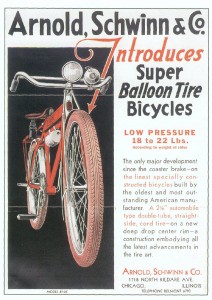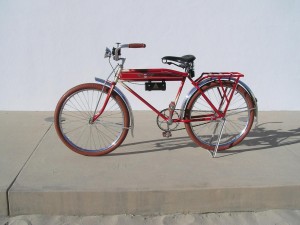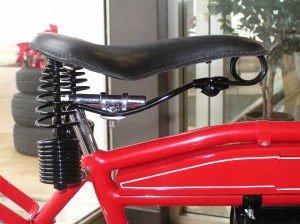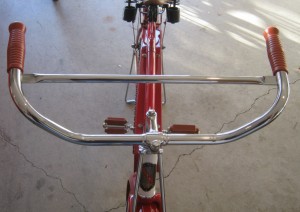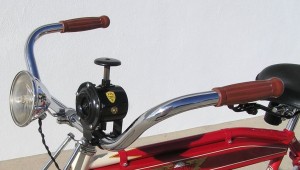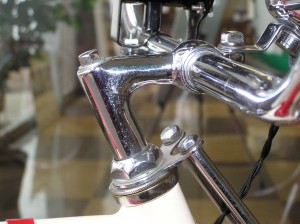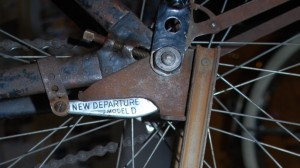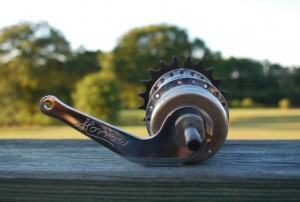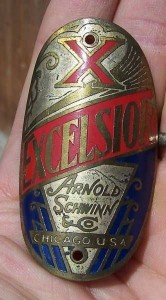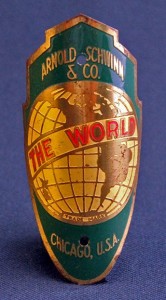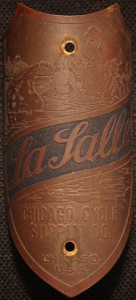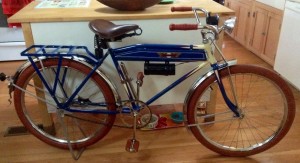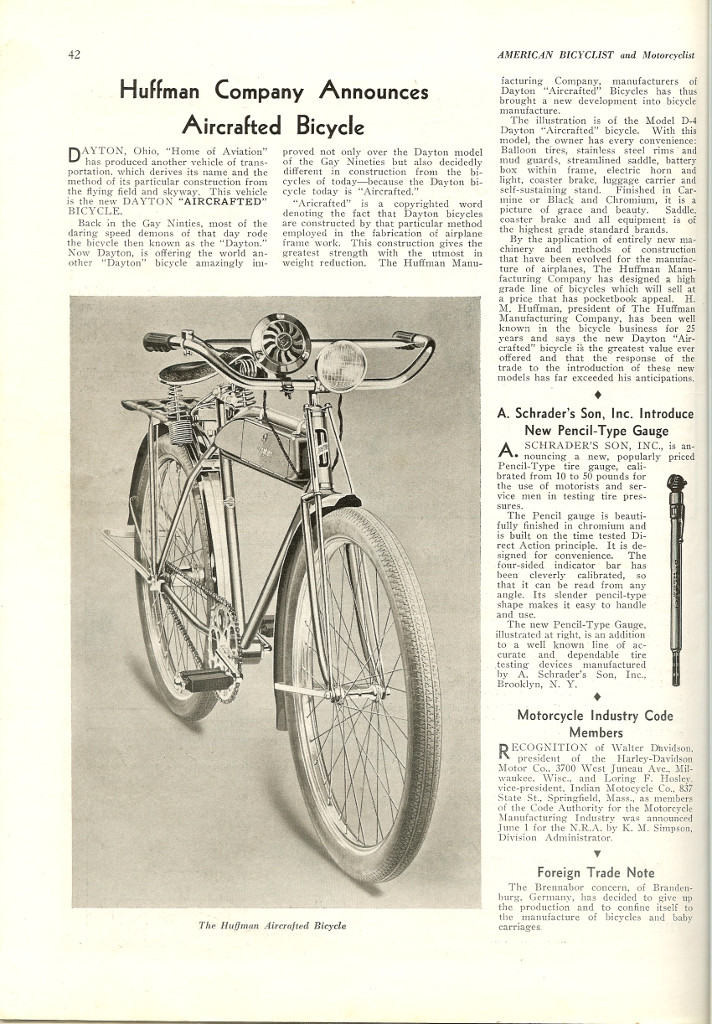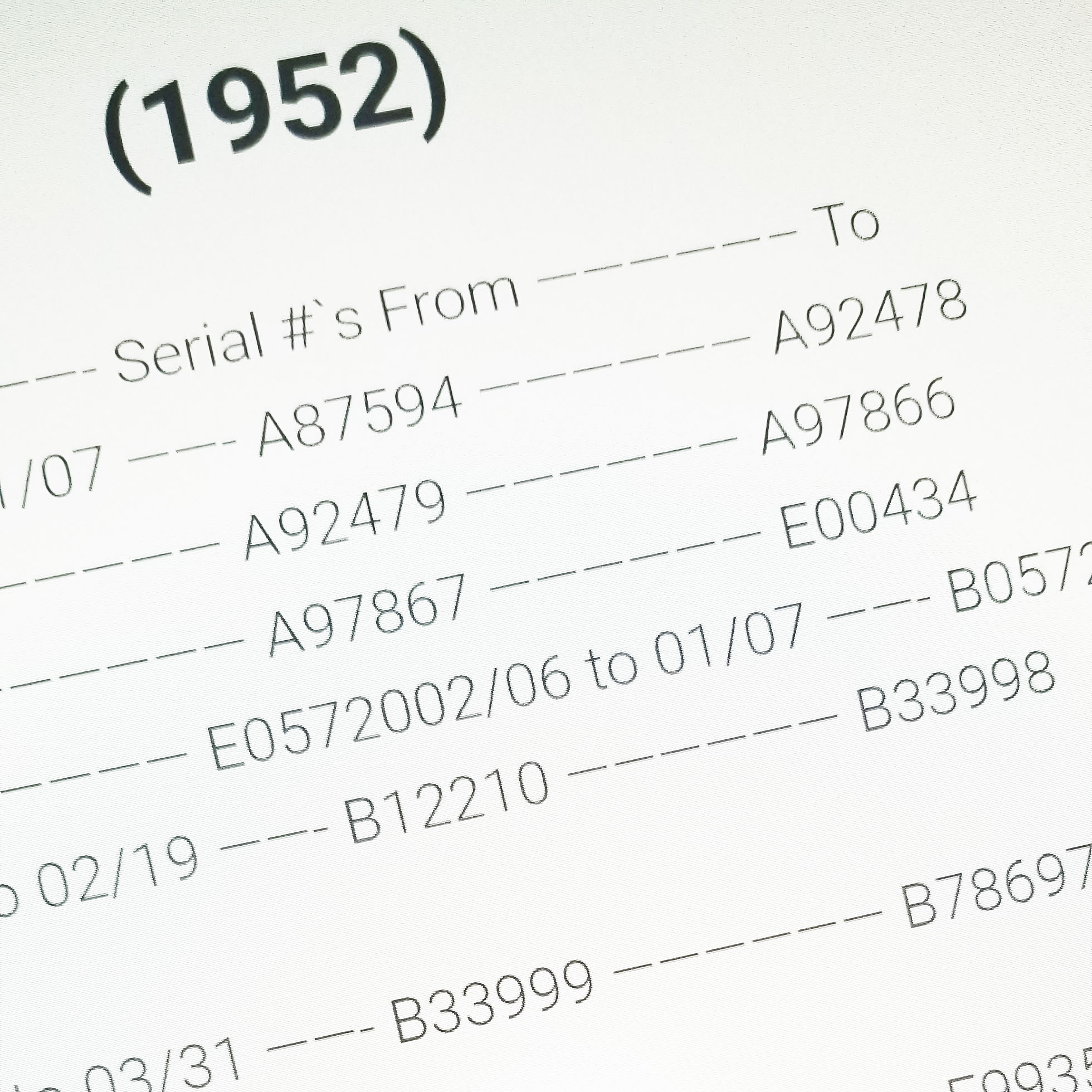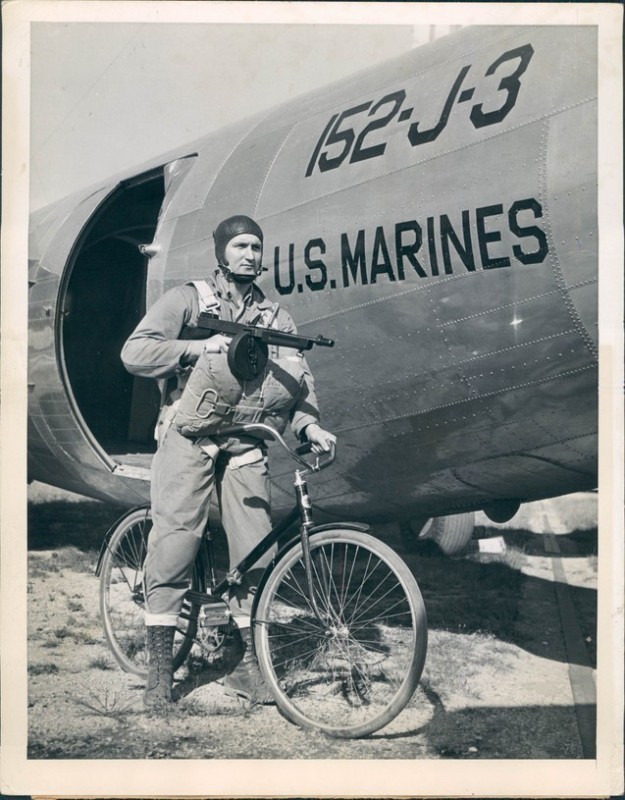The First American Balloon Tire Bicycle
by Shawn P. Sweeney · August 11, 2020
By
Shawn Sweeney and Gary Meneghin
Schwinn acquired the Excelsior and Henderson motorcycle companies in 1911 and 1914, respectively. Frank Schwinn, the son of the Schwinn company founder, Ignaz Schwinn, soon became the head of the Excelsior –
Henderson Motorcycle Division of Schwinn. He was an excellent motorcycle engineer. However, at the close of the 1920s, the stock market crash decimated the American motorcycle industry, taking Excelsior-Henderson with it. Arnold, Schwinn, & Co. (as it remained until 1967) was on the verge of bankruptcy. With no buyers, Excelsior-Henderson motorcycles were discontinued in 1930.¹ Frank W. “F. W.” Schwinn, at the age of 36, then took over day-to-day operations at Schwinn. Frank decided to put all his efforts toward bicycle design, production and sales. Frank succeeded in developing low-cost models that brought Schwinn recognition as an innovative company, as well as a product that would continue to sell during the inevitable downturns in business cycles. In 1931, Ignaz and Frank Schwinn decided to travel to Europe to get ideas that would increase bike sales. While in Germany, they saw balloon tires on bicycles. In the U.S., all bikes had sew-up tires, “basically a glorified piece of continuous garden hose with a valve”. These tires were almost impossible to repair. Frank disliked these tires and wanted to convert to something more similar to motorcycle tires. These tires softened the ride on rough roads and cobbled streets. It was also much easier to fix flats on these tires, just simply repair the rubber inner tube. Frank concluded that these tires would be a strong selling point for the American market. In fact the early ads for balloon tire models emphasized the soft ride with low pressure tires of 18 -22 lbs. The balloon tire measures 26″ x 2 1/8″ compared to previous tires measuring 28″ x 1 1/2″.
Upon return from his European trip, Frank met with a bike industry group in Chicago to explain his plan. The plan was to add balloon tires to bikes and make them look more like motorcycles with the addition of a faux gas tank (i.e., a tool box tank), a motorcycle rear carrier, a Klaxon push lever horn and a chromed motorcycle head light. Schwinn even proposed the use the name Motobike and a near copy of the Harley-Davidson eagle wings logo on the tool box tank to make the bikes more motorcycle like. The other bike manufacturers were not at all receptive to the idea and felt that there was no reason to change the way bikes had been manufactured for decades. This turned out to be a serious error in judgment on their part.²
Frank also met obstacles in getting the new rims and tires manufactured. Because of their long relationship with Firestone, they finally agreed to produce the new rims. He initially approached U.S. Rubber to produce the tires but they dismissed it as a “silly idea”. He then went to Fisk Tire Company and they agreed to produce tires for 5,000 bikes. Unfortunately, Fisk failed to make the tires properly, so Frank went back to U.S. Rubber and said “make the tires or I will import them”, so U.S. Rubber agreed.³
Department stores also scoffed at the idea and would not carry Schwinn’s new balloon tire bikes. So Frank said that they would only sell these bikes to small independent bike shops. As it turned out, these small bike shops would now finally have something that the department stores could not get. The sales of small shops soared following the introduction of these balloon tire bikes².
Despite the chilly reception to his ideas, in 1933, Frank introduced the Schwinn Motobike B10E, actually a youth’s bicycle designed to imitate a motorcycle. Frank surmised correctly that if a young boy could not afford a motorcycle then the next best thing would be a bike that looked like a motorcycle, Frank was right – Schwinn’s market share dramatically increased from 8% to 16% from 1933 to 1935. The B10E was produced from 1933 to 1935. By 1935, 97% of all bikes sold in the U.S. had balloon tires.² This was a dramatic trend change in the bicycle industry. For about the next 25 years the balloon tire bike would rule the roads.
Some people in the bicycle hobby argue that Sears was the first to introduce balloon tires. The 1931-32 Sears Fall-Winter catalogue introduced the Allstate balloon tire bicycle. This was a 28 X 2 inch tubeless tire – similar to the construction of many auto and motorcycle tires. Sears advertised that it was a balloon tire that represented the first bike innovation in 50 years. The Schwinn Super Balloon tire was 26 x 2 1/8 and had an inner tube. While some argument exists to which company actually introduced the first balloon tire bicycles in the United States it is generally accepted that Schwinn produced the first balloon tire bicycles in the spring of 1933.
Schwinn Balloon Tire Models
The 1933 Schwinn balloon tire model line-up consisted of seven different models (six boys and one girl). The model designation for these bikes started with “B” (balloon) e.g. B10E while the same bike with 28 x 1 ½” tires was designated simply as #10E. The following is a list of the balloon tire bike models:
- 4
B 1 ½ (juvenile) - B 1 ½ E (juvenile)
- B1 Camelback (juvenile)
- B3 Ladies
B4 Camelback - B9 Motorbike-unequipped
- B10E Motorbike-equipped (rack, battery can and light, tank, friction horn)
The 28” bikes included the same model line-up but with the addition of a #5 Roadster. Additionally a Model “R” (racer) equipped with 28 x 1 1/8” tires was in the line-up.
The B10E Motobike
The focus of this article will be on the top-of-the-line B10E. The following are the specifications for each of the three years the B10E and B10EC-(1935 only).
Restored 1935 Schwinn B10E Motobike (Courtesy of Gary Meneghin)
1933
1933 Specifications from Schwinn catalog
- B10E
Frame-18 x 22 inches - Tires-26 x 2 1/8” cord balloon
- Saddle-No. 1 Bucket
- Handlebars-Chromium finish with brace
Pedals-#10 Torrington
Guards-Chromium finish - Rims-Deep drop center chromium finish
- Color-Black with red, Optional blue or red with white
- Coaster brake-Musselman, Morrow, or New Departure
- Equipment-Rack, tank, Delta light and can, friction horn
1934
In 1934 two changes are noted in the description of the B10E. First a ‘tall’ frame (20 x 24”) is introduced. Secondly the fenders are now mentioned as being stainless steel.
1934 Specifications from Schwinn catalog
- B10E
- Frame-18 x22 inches or 20 x 24 inches
- Tires-26 x 2 1/8” cord balloon
- Saddle-No. 1 Bucket
- Handlebars-Chromium finish with brace
- Pedals-#10 Torrington
- Guards-Stainless Steel
- Rims-Deep drop center chromium finish
- Color-Black with red, Optional blue or red with white
- Coaster brake-Musselman, Morrow, or New Departure
- Equipment-Rack, tank, Delta light and can, friction horn
1935
The description for 1935 is essentially unchanged from the 1934 specifications except that now the saddle is described as “padded bucket type” and the pedals are described as “high grade, rubber”. This possibly indicates that Schwinn began using other suppliers for these parts.
1935 Specifications from Schwinn catalog
- B10E
- Frame-18 x22 inches or 20 x 24 inches
- Tires-26 x 2 1/8” cord balloon
- Saddle-Padded bucket type
- Handlebars-Chromium braced with large rubber grips
- Pedals-High grade, rubber
- Guards- Stainless Steel
- Rims-Deep drop center chromium finish
- Color-Black with red, Optional blue or red with white
- Coaster brake-Musselman, Morrow, or New Departure
- Equipment-Rack, tank, Delta light and can, friction horn
In 1935 a budget priced version of these bikes was offered. The two notable differences were the painted fenders instead of stainless and the handlebars are not mentioned as being “braced”. The handlebars on this version appear to be what are typically called ‘Scout’ bars.
1935 Specifications from Schwinn catalog
- B10EC
- Frame-18 x22 inches or 20 x 24 inches
- Tires-26 x 2 1/8” cord balloon
- Saddle-Padded bucket type
- Handlebars-Chromium finish with large rubber grips
- Pedals-High grade, rubber
- Guards- Enameled to match Rims-Deep drop center chromium finish
- Color-Black with red, Optional blue or red with white
- Coaster brake-Musselman, Morrow, or New Departure
- Equipment-Rack, tank, Delta light and can, friction horn
Observations and Details
The following notes are based on research of period literature, discussion with other collectors, and examination of original bicycles. As with other manufacturers of the time Schwinn did not produce 100% of the bicycle in their factory. Components to include handlebars, wheel sets, lights, horn, seat, tires, pedals, reflector, and seat were all sourced from various suppliers. The following are what was typically installed and would be accepted as correct for a restoration.
- Although Schwinn literature does not list the B10E model for 1936 several retailers were still offering this model into the 1936 model year.
- There is a question concerning why Schwinn literature refers to this bike as a “Motorbike” yet the decal on the tank says “Motobike”. Some collectors say this was due to a lawsuit over the name. This does not seem likely given the literature into 1936 still refers to the bike as a “Motorbike”.
- Other than the standard colors of black, red, and blue only a green bike has been reported.5 This is plausible since the 28” Motobike is known in green and it is likely a few early B10Es were painted this color as well.
-
- Several different chain rings were used on the B10Es. Some of these were possibly specific to the badge and others to particular retailers. The most common chain ring found on the B10E is the “sweetheart” chain ring. The so called “Aerocycle” chain ring is found on Henderson and Majestic badged bikes. The chain ring shown on the admiral badged bike was also used on Meads and Pullmans. They are all 1” pitch. The crank is a standard 7” Schwinn ‘dog leg’ crank.
|
Typical
“Sweetheart” Chain Ring |
 “Aerocycle” Chain
Ring |
 Admiral Chain Ring |
 ‘Dog leg’ crank |
- The seat used was the Mesinger long spring seat referred to in the literature of the time as “No. 1 Bucket”. It appears that two different styles of chassis and clamps were used on the seats. It is possible that Troxel seats were used on these bikes as well.5
|
Typical seat chassis/clamp
|
Alternate style seat chassis/clamp
|
- The only decals on the B10E are the standard Schwinn seat tube decal, and the tank decal. The tank decal is a winged “MOTOBIKE” decal. Some earlier 28” bikes had a “The World” decal on the tank and it is possible some B10Es also carried this decal.² While it became fairly common for the 1936 and later Schwinns to have a decal or painted brand on the down tube this is not often seen on the B10E. Shown below is an example of, what is left of, an “Admiral” script on the down tube of an original bike.
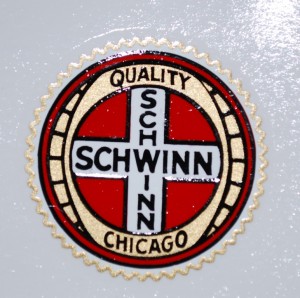 Seat tube decal |
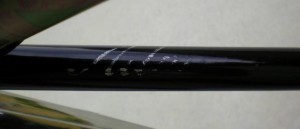 “Admiral” on down tube |
 “MOTOBIKE” tank decal (typical) |
 “The World” tank decal |
- The EA Klaxon horn with the five screw face is the horn most likely to be used. The chrome Delta ‘teacup’ light with the switch on the light and black Delta #6 can without switch are what is depicted and called for in the contemporary literature. The battery cans use a #6 1.5 volt dry cell battery (sometimes referred to as a telephone battery). Some bikes are found with the painted ball style delta light with the switch on the can. These may be replacements or possibly the later models were equipped with them.
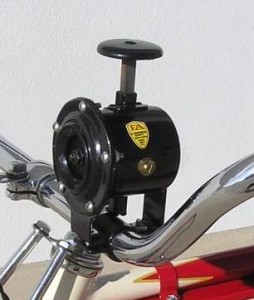 EA Klaxon horn |
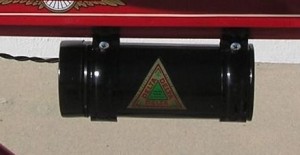 Delta #6 battery can |
 Headlight lens |
 Side profile of chrome ‘tea cup’ light |
- While most restorers opt for red grips and pedals most B10Es were originally equipped with black ribbed grips and black block Torrington 10 pedals. The braced handlebars typically found measure approximately 22” across. As stated in the literature for the B10EC the bars are the same except they have no brace.
- As discussed above the fenders were chrome plated, stainless steel, or painted (EC model only). The fenders are a typical ‘rain gutter’ design fender with a single fender rivet to the flat brace. The front has a single brace at the rear and there are both a ‘duck tail’ and a straight variety in both stainless and chrome. The rear also has a single brace and a reflector that measures approximately 1 ½” across.
 Straight front fender |
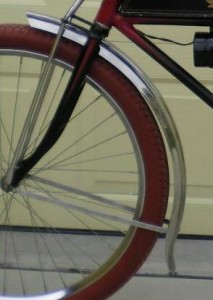 ‘Ducktail’ front fender |
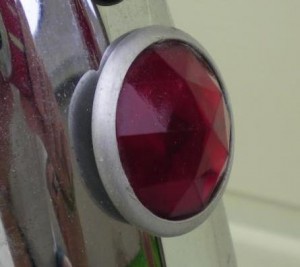 Rear fender reflector |
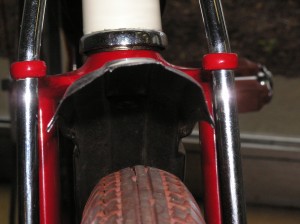 Fender profile |
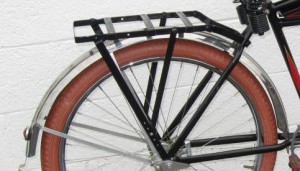 Rear fender/rack |
- The rack used on all B10Es was a simple box type flat pressed steel variety. The front is attached to the seat stays and the main support legs attach to the rear axle. The drop stand used on the B10Es seems to be a fairly specific Schwinn item and is the same one used on the Aerocycle.
 Rack |
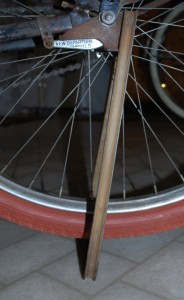 Drop stand |
- The tires shown in the original advertisement for the bike are red and that is generally what most B10Es whether original or restored have on them now. The rims are a drop center, slightly stepped rim. The front hub is a New Departure Model W hub. As noted in the factory literature the B10E could be equipped with a Morrow, Musselman, or New Departure rear hub. The Morrow hubs are date stamped with an alpha numeric code. The letter corresponds to the year and the number (1-4) indicates the quarter of the year. The letters start with “A” for 1931 so for the B10Es “C” is 1933, “D” is 1934, “E” is 1935, and “F” is 1936. So, for instance, a code of D1 would indicate the first quarter of 1934. The other hubs cannot be dated in this manner.
- The B10Es like any other Schwinns of the period can be found with a myriad of badges. Schwinn was distributing through large retailers such as Chicago Cycle Supply as well as hundreds of small retailers. Lincoln, Liberty, Excelsior, Admiral, Henderson, Majestic, The World, and LaSalle are some of the many badges encountered. A popular badge surrounded by some lore is the Chicago Tribune Special badge. Some accounts say that these bikes were awarded to the fastest or best delivery riders. Because this badge has been found on several girls bikes it seems likely this was more a promotional item rather than a prize.
References and Acknowledgements
The authors wish to thank all of those that contributed to making this article possible.
¹Schwinn Bicycle Company, Wikipedia 2014 retrieved from http://en.wikipedia.org/wiki/Schwinn_Bicycle_Company – website
²Pridmore, J. & Hurd, J. (2001). Schwinn Bicycles. MBI Publishing
³Judith Crown and Glen Coleman. Nov 1996. No Hands. The Rise and Fall of the Schwinn Bicycle Co. An American Institution.
4Hurd, J., & Gordon, T. A. (1992).
Schwinn-built bicycles: Super Balloon Tire Bicycles 1933-World War II.
5 Bob Ujszaszi-personal communications, December 2014
Scott McCaskey-The Classic and Antique Bicycle Exchange (CABE) http://thecabe.com/
Dave Stromberger- Dave’s Vintage Bicycles http://www.nostalgic.net/
Ray Hanusik the owner of the original black 1934 Admiral and Mark Lavarnway the owner of the restored blue Majestic were very accommodating with both information and pictures. Jack Daniels also provided pictures of a restored Excelsior badged bike that he owned and various components of that bike are pictured as well. A special thanks to the many other members of the CABE who participated in the forum and provided either information or pictures necessary to complete this monograph.

